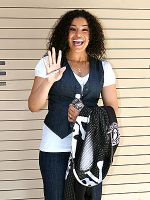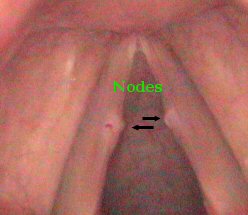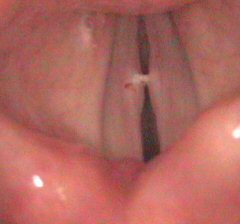 I read this morning that American Idol (barf) winner Jordin Sparks is on vocal rest after suffering an acute vocal cord hemorrhage before going on tour with Alicia Keys.
I read this morning that American Idol (barf) winner Jordin Sparks is on vocal rest after suffering an acute vocal cord hemorrhage before going on tour with Alicia Keys.
As many of you know, the Fink herself had vocal cord surgery back in ’95. I was an assistant marching band director, and spent 6 weeks in the summer shouting at 130 kids on the field. I was also a singer on the weekends, so that royally bit. The more I yelled, the more the cords bled…the more I sang, the worse everything got.
So I was way past where Miss Sparks is right now. I had to have surgery to remove what are called “vocal nodules” or “singers’ nodes.” Check out the grotesque pictures:
 These photos are taken by putting a camera down the patient’s throat, so you’re seeing a bird’s-eye view. Notice the small callouses on both vocal folds. From overuse/misuse and muscle strain, these “nodes” appear, usually one on each fold — and if they get big enough, they don’t go away. This picture is of a person at rest; that is, she is just breathing and not singing.
These photos are taken by putting a camera down the patient’s throat, so you’re seeing a bird’s-eye view. Notice the small callouses on both vocal folds. From overuse/misuse and muscle strain, these “nodes” appear, usually one on each fold — and if they get big enough, they don’t go away. This picture is of a person at rest; that is, she is just breathing and not singing.
The next picture is taken as she tries to sing. Notice how the vocal cords — which are supposed to fit perfectly together like a set of closed curtains — are forced apart in places by the nodes.  That causes a mammoth air leak, which is where the “hoarse” voice sound comes from. Therein lies the danger, my friends. If you’re ever going to talk or sing correctly again, you need to have them scraped off. That’s what happened to me, and it wasn’t pleasant.
That causes a mammoth air leak, which is where the “hoarse” voice sound comes from. Therein lies the danger, my friends. If you’re ever going to talk or sing correctly again, you need to have them scraped off. That’s what happened to me, and it wasn’t pleasant.
Unfortunately, vocal nodes are more common than you might think. Lots of famous singers have suffered with them, and many had to have surgery to get them removed. Check this list:
- Natalie Imbruglia
- Justin Timberlake
- Whitney Houston
- Robert Plant (Led Zeppelin)
- Julie Andrews
- Bette Midler
- Joss Stone
- Luciano Pavarotti (WHAT? Opera singers with nodes? What’s the world coming to…)
So, like I always tell my singers (many of whom are cheerleaders and athletes who scream themselves silly at games): Those nickel-sized pieces of skin are the only means by which you can make sound for the rest of your life. Take care of them.
Peace (and vocal rest),
Dr. Fink
Photo credit: voicedoctor.net

I have the same problem with my vocal folds. Do you know who THE doctor is to do this surgery? Who did Bette Midlers? I think Dr Gerald Berke but I am not sure, is best around – opinions?
Thanks
Hi Randy:
Not sure who did Bette’s surgery. My surgeon was Arun Mathur in Wooster, Ohio. I was thrilled with his expertise, and I’ve been singing ever since 6 weeks after surgery. And I’m a choral director, so I sing every day. I couldn’t have been more pleased.
The big thing is to first try the least invasive process: allow your voice to rest. Silence is the only medicine. If your folds aren’t banging together, they can stay apart and heal (unless, of course, the nodes have progressed too far and are now scarred, in which case they will have to be removed surgically).
Best of luck to you – it’s a big decision for sure, but in my case, it really paid off.
RF
Hi, Dr. Fink. I was really intrigued about your blog, and frankly, has been the most informative coming from someone who actually went through this process. I do have a question, how much did the nodes impair your singing and speaking? Also, did the nodes wear your voice out alot? My last question is how much did it cost you to get the surgery as well as speech therapy afterwards? I’m sorry, I have so many questions! Please and thank, happy fourth of july!
Hello John, and sorry about the delay on my response. Firstly, I’m not a doctor, although I play one on the Internet. Seriously, I’m a choral director who has definitely been through the mill on this issue, and it was a huge learning process.
Seriously, I’m a choral director who has definitely been through the mill on this issue, and it was a huge learning process.
The nodes completely impaired my singing and speaking. My voice was very hoarse and raspy; it was work to get enough volume out to be heard, so you can imagine how difficult teaching (choir!) was. My pipes were completely shot. I had nothing.
After the surgery, I was remanded to six weeks of complete silence while the folds healed. I taught my choirs with a white board and hand signals, during which time they became keenly attuned to my body language, facial expressions and hand signs. It was actually cool, because they had to work harder and concentrate more to “listen.” I said I was going to write an article about the experience for my trade magazine, but I never did.
Fortunately, my health insurance covered the cost of the corrective surgery. I’m not sure what it would cost someone with no insurance.
Hope this helps, and moreover, I hope you’re not experiencing these problems anymore!